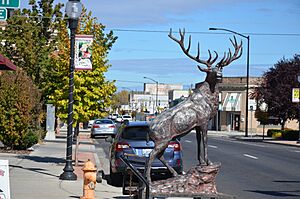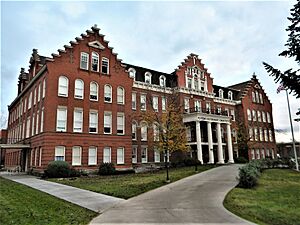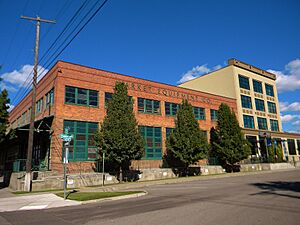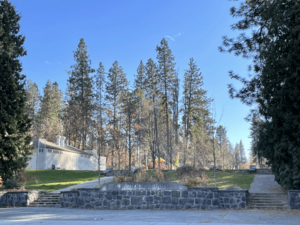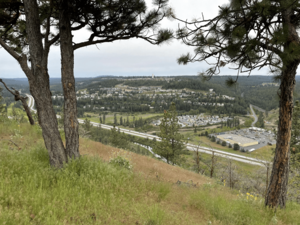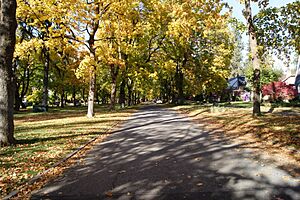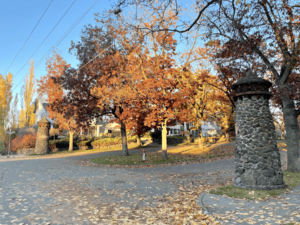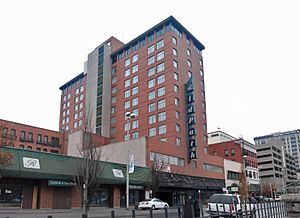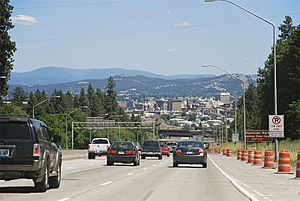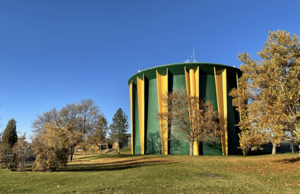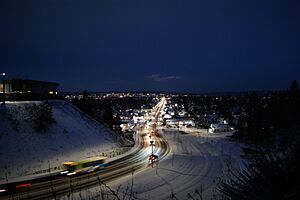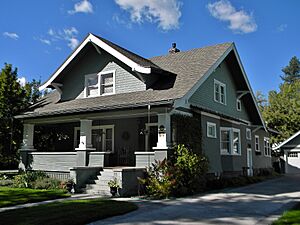Neighborhoods in Spokane, Washington facts for kids
The neighborhoods in Spokane, Washington are officially grouped into three main areas by the city government. These are called City Council Districts 1, 2, and 3. Each district has many official neighborhoods, and each neighborhood has its own council. People also have informal names for areas based on how they look, their history, or where they are, like South Hill or Hillyard. This article lists the neighborhoods based on the official city groups. Any unofficial areas are mentioned within the official neighborhood they are part of.
Spokane's neighborhoods show how the city has grown, from old Victorian times to today. Spokane started as a big train hub in the early 1900s, before cars were common. This really shaped how the city and its neighborhoods look. Because trains were the main way to get around back then, Spokane's first neighborhoods were busy streetcar suburbs. These were places outside the busy downtown where companies built homes near electric train lines, which made them easy to live in and valuable.
Most of Spokane's city area has neighborhoods that were planned out with straight, checkerboard streets. This design was great for efficient train travel. These areas often had a small shopping center nearby for people living there. Spokane's electric train lines went from Francis Avenue in the north all the way to 38th Avenue on the South Hill. After these older streetcar neighborhoods, you find typical suburban areas built after World War II, mostly with houses for one family.
District 1 (Northeast)
The northeast part of Spokane stretches about 7 miles (11 km) north from Downtown Spokane towards the suburban Mead area. It's bordered on the west by Division Street, which is a main north-south road. To the south, it's bordered by Interstate 90. This area is mostly for homes, but it also has big shopping areas and Gonzaga and Whitworth Universities. Shopping centers like Northtown Mall and Northpointe Plaza are found along Division Street.
Bemiss
Chief Garry Park
This neighborhood is named after Spokane Garry, a famous leader. It's a long neighborhood, stretching over four miles from near the city center at Trent Avenue, across the Spokane River, northeast to Felts Field. Spokane Community College is located here.
Hillyard
Hillyard used to be its own city, but it later became part of Spokane. Downtown Hillyard, which is along Market Street, is listed as a historic district. Hillyard was named after James J. Hill, a big boss of the Great Northern Railway. It is known for being a less wealthy area of Spokane.
Logan
The Logan Neighborhood is a living area just north of Gonzaga University in central Spokane. Many university students live in the homes here.
University District
Northeast of downtown, there are two university areas. One is Gonzaga University. The other is the Riverpoint Campus. This campus has parts of Washington State and Eastern Washington Universities. It also has a branch of the University of Washington medical school. A new school, Great Northern University, is also here. Many students live in homes around the Logan Neighborhood. There are plans for more students, homes, and fun places for young people in the future. This area is seeing a lot of new professional and medical businesses. They are mostly east of Division, west of Hamilton, and north of the I-90 freeway.
Minnehaha
This area is along Upriver Drive on the north side of the Spokane River. It's about 5 miles (8 km) east of downtown Spokane. It's famous for the granite climbing rocks and trails for hiking and biking at John H. Shields Park. The Centennial bike trail and small parks with swimming spots along the river make this a popular place for city residents. Homes closer to the river are older, while some newer housing areas are on the hills above.
Nevada Heights
Nevada Heights was created in 2016. Before that, it was part of the Nevada/Lidgerwood neighborhood, which was split at Francis Avenue. This neighborhood is the southern half of the old one. In Northeast Spokane, it's home to Northtown Mall. This mall was once the biggest west of the Mississippi. Many houses here were built in the mid-1970s, but new homes are also common. Whitman Elementary School, Garry Junior High School, and John R. Rogers High School are all in Nevada Heights.
Shiloh Hills
This neighborhood was also created in 2016 when the Nevada/Lidgerwood neighborhood was split at Francis Avenue. Shiloh Hills is the northern half of the old neighborhood.
Whitman
District 1 & 2 (Northeast and South)
East Central
This neighborhood was cut in half when Interstate 90 was built many years ago. It is still recovering from that change. The area is at the bottom of the South Hill, east of Downtown, next to the freeway. Plans to add more lanes to I-90 might affect the neighborhood further. The homes that are still strong in the area are mostly south of I-90, in a part called Liberty Park. The area north of the freeway and east of Hamilton hasn't been updated much since it was first built in the early 1900s.
South Perry
This street area, which became a neighborhood, started in the late 1800s, like much of Spokane. In the past, it had two lumberyards, a butcher shop, a barber shop, a library, an ice cream shop, a bakery, a dry cleaner, and several grocery stores. Today, the South Perry Business District is becoming popular again. Trendy restaurants, bars, shops, and cafes have opened in many of the old stores along Perry Street.
South Perry was settled early in Spokane's history because it's just southeast of the city center. Because of this, it has a lot of history. Grant Elementary has been open since 1900, though the original building is gone. The park next to it, Grant Park, was started in 1908. One of Spokane's oldest churches, the Liberty Park Methodist Church, has been open since 1912. Sonora Smart Dodd, who is known for starting Father's Day, lived in this neighborhood with her husband. Their Dodd House, built in 1913, is listed as a historic landmark. Some buildings in the business district are from the early 1920s. They show nice examples of local granite stonework and decorative shingles. There's even a Dutch windmill, which is a famous sight in the area. The Spokane Buddhist Temple is also in South Perry.
District 2 (South)
The south side of Spokane includes Downtown, Browne's Addition, and the South Hill. These areas have some of Spokane's oldest homes. Geographically, the "hill" covers the entire city area south of downtown, from east to west. It has very different types of land from one block to the next. From Downtown, you can see the South Hill, which is covered in evergreen trees. Two big buildings stand out: Sacred Heart Medical Center, Spokane's largest hospital, and the Cathedral of St. John the Evangelist. This cathedral is the main church for the Episcopal Diocese of Spokane and is a beautiful example of modern English Gothic architecture.
Browne's Addition
This is a National Historic District west of Downtown. Browne's Addition was Spokane's first fancy address. It's known for its old mansions built in Queen Anne and early Craftsman styles. Spokane's rich early citizens built these homes. The area also has Coeur d'Alene Park and the Museum of Arts and Culture (MAC). A special part of the MAC is the Campbell House. This mansion from the early 1900s was designed by famous architect Kirtland Cutter. It was built by Amasa Campbell, a local mining boss. His daughter, Helen Campbell, gave the house to the Eastern Washington Historical Society. They later built a museum on the lawn. The English Tudor Revival home still has most of its original decorations and is a popular place to visit.
Cliff/Cannon
This neighborhood is bordered on the north by Interstate 90, and it lies between Third and Fourth avenues. In the far northern part are Sacred Heart Medical Center and Deaconess Hospital. These are the main hospitals in Spokane's medical area. Between the two hospitals is the historic Lewis and Clark High School. This part of Cliff/Cannon is separated from the rest of the neighborhood by a very steep hill. In some places, this hill is a sheer cliff of exposed rock. People often say this hill marks the start of the South Hill area of Spokane. This is where the city center changes into the homes on the south side of the city. On the western edge of Cliff/Cannon is another steep hill, which was carved by Latah Creek. The BNSF Railway and Inland Empire Way separate the Latah Valley neighborhood from Cliff/Cannon and the South Hill.
Cannon's Addition
Cannon's Addition was named after Anthony McCue Cannon, who first planned it out. There was a great need for homes after the Fire of 1889. Many architects came to Spokane because the city was growing so fast. Most of Cannon's Addition was built between 1900 and 1925. The first streets built were Third, Fourth, and Fifth Avenue. The northern part of Cannon's Addition, closest to downtown, quickly became an area where important Spokane citizens built their houses. In the original 1883 plan for Cannon's Addition, the streets only went as far south as Tenth. Eleventh, Twelfth, Thirteenth, and Fourteenth were added later.
In 1887, J.T. Davis and Henry Brooks opened a brickyard on South Monroe. This was between what would later be Cannon Hill Park and Cannon's Addition. The area had a lot of clay. The brickyard later became the Washington Brick, Lime & Sewer Pipe Company. By 1900, Cannon's Addition started to grow more. It became a neighborhood for middle-class families. Over the next fifteen years, Spokane grew from 30,000 people to 100,000. Once the brickyard ran out of clay, the company moved. By 1909, the land was being used for homes and Cannon Hill Park. After 1920, very few new homes were built in Cannon's Addition. The houses built during its main growth time included styles like American Foursquare, Tudor Revival, and Neoclassical. There were also simpler Craftsman and bungalow style houses.
Comstock
Comstock is mostly a neighborhood with homes. It's south of 29th Avenue and west of Perry Street on the South Hill. It was built in stages. First, homes were built along streetcar lines. Then, more homes were built during the housing boom after the war. Most of the homes are for single families, but there are a few other types of buildings. Manito Shopping Center, at 29th and Grand, is an important shopping area for the South Hill. Sacajawea Middle School and the Lewis and Clark High School sports fields are in the middle of the neighborhood.
Grandview/Thorpe
Two valleys are on the north and east sides of this neighborhood. To the east is the Latah Creek valley and the Latah Valley neighborhood. To the north is the less steep valley of Garden Springs Creek. I-90 separates Grandview/Thorpe from the West Hills neighborhood. However, these two official city neighborhoods share the unofficial Sunset Hill neighborhood. Grandview refers to the housing area in the upper part of the northern half of the neighborhood. It started being built in the 1980s. From here, you can see much of the north and south sides of Spokane, Downtown Spokane, Krell Hill, and the Latah Valley. Thorpe is a road that goes west-southwest from U.S. Route 195 through a valley just south of that housing area. The area right around and south of Thorpe Road is less developed than the Grandview section.
Latah/Hangman
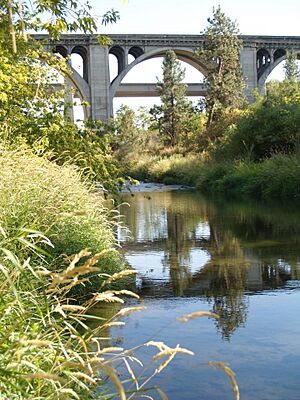
This is a very large neighborhood. It stretches from the Riverside Ave. bridge over Latah Creek in the north, all the way to the very southern edge of Spokane. The neighborhood's land is split into two clear areas. The older Vinegar Flats neighborhood is on the valley floor in the northern part. The newer Qualchan and Eagle Ridge developments are to the south on the western hillsides. Because the neighborhood is so large and is cut by U.S. Route 195, railroads, and Latah Creek, there are smaller, separate groups of homes. The valley floor is about 1,800 feet (549 m) above sea level. The hills around it rise to about 2,300 feet (701 m) on the east and 2,200 feet (671 m) on the west. Latah Creek meets the Spokane River just north of the neighborhood. East of the creek is a steep hill, which is undeveloped parkland except for railroad tracks in the northern part. This area is called "the bluff." On the west side, the hill is not as steep and has more buildings. Marshall Creek flows into Latah Creek from the west, near where Cheney-Spokane Road and U.S. 195 meet. Garden Springs Creek flows through Latah Valley, entering just upstream of the I-90 bridge.
Vinegar Flats
Vinegar Flats is on the valley floor and is the oldest inhabited part of Latah Valley. Inland Empire Way is the main road in Vinegar Flats, connecting it to the rest of the city. This area has a mix of small homes, empty lots, greenhouses, green areas along the creek, and city parks. Just north of the neighborhood are the tall bridges over the creek for I-90, Sunset Boulevard, and the BNSF railroad. Below and around those bridges is High Bridge Park. The park is mostly undeveloped along the hillside and creek. But it has a picnic area, mowed grass, and a disc golf course.
Qualchan/Eagle Ridge
This area has two separate but close-by suburban-style developments. They are located along the hills in the southwestern part of Latah Valley. This is the newest part of the neighborhood, as these two developments are still growing. This is an unofficial neighborhood. Its borders are roughly where Cheney-Spokane Road and U.S. 195 meet in the north. The city limits are to the south and west, and U.S. 195 is to the east. At the northern end is the shopping center of Latah Valley. It has several businesses, including a grocery store, gas station, restaurants, a bank, and other small shops.
Lincoln Heights
Lincoln Heights is a middle-class neighborhood. It covers most of the eastern side of the South Hill. It goes from Southeast Boulevard (Perry Street, north of 29th Avenue) to the city limits. 37th Avenue is the southern border. The neighborhood stretches north to a ridge that looks over the Spokane River valley. The neighborhood's center is at the intersection of 29th and Regal. The area around this intersection is one of the main shopping districts on the South Hill. Apartment buildings are common around the intersection. The rest of the neighborhood has mostly single-family homes.
Manito/Cannon Hill
The borders of this area are roughly from Arthur Street to Lincoln Street (east to west) and from 14th Avenue to 37th Avenue (north to south). It's best described as the area right around Manito and Cannon Hill Park, which are at its center. This neighborhood covers a pretty large area. Long ago, Manito Park was a zoo with many different "exotic" animals. It had an owl barn, penguins, and big cats. The neighborhood sends many kids to local elementary schools, like Wilson, Roosevelt, Hutton, and Jefferson. There's also the Cataldo Catholic School one block north of Cannon Hill Park. Most elementary students then go to Sacajawea Middle School and then Lewis and Clark High School. This neighborhood is mostly home to middle-class families. It has houses from many different times, from Mid-Century Modern to Victorian to Arts & Crafts bungalow-style homes. Manito and Cannon Hill Park each have a boulevard nearby. These boulevards feature many of the remaining Craftsman bungalow-style homes, some built as early as 1904.
Peaceful Valley
Peaceful Valley is a charming neighborhood with homes that go down into the Spokane River Gorge, just west of downtown. It's now changing because of fancy new buildings in nearby neighborhoods like Browne's Addition, Kendall Yards, and West Downtown. Still, Peaceful Valley remains one of the quietest, greenest, and most affordable neighborhoods. It's also easy to walk to the city center from here. A few luxurious homes along the river mix with more small bungalows and apartments. Some of these are tucked below the Maple Street Bridge. People's Park and Latah Creek border the neighborhood to the west. In many ways, Peaceful Valley looks much the same as it did when the movie Benny & Joon was filmed here in 1993.
Rockwood
Rockwood is an older neighborhood with many homes listed on the Spokane Register of Historic Places. It was part of Spokane's big plan created by the Olmsted Brothers. They were the sons of Frederick Law Olmsted, who helped design Central Park in Manhattan. The Olmsted Brothers suggested curving streets with a main boulevard winding through the middle of the neighborhood. Many street names in Rockwood help show what the land looks like. Along with the main boulevard, streets like Overbluff, Upper Terrace, Highland, Plateau, Pinecrest, and Woodcliff all mention their geographic setting.
Half of Rockwood sits on a winding hillside. This is where the Spokane River valley rises sharply to the higher land of the Columbia Plateau. In some spots, the land changes so much that streets are cut off. For example, on Perry Street, stairs connect Overbluff with 20th Avenue instead of a paved road. Above the hillside, the land is mostly flat. This change in height means there are many exposed rock formations in the neighborhood. Along with the rocks, this old neighborhood has many old, tall trees. This makes "Rockwood" a very fitting name. There are many large homes in the neighborhood, especially along Rockwood Boulevard and the hillsides around it. The rest of the neighborhood generally has smaller single-family homes. Some special buildings include the Spanish Colonial Hutton Elementary School at 24th Ave. and Plateau Rd. Also, the Gothic Revival St. John's Cathedral is at 12th Avenue and Grand Boulevard. The shopping area stretches north from the cathedral along Grand.
Southgate
Southgate is in the very southeast part of the city. It's bordered on the north by 37th Avenue, on the west by Perry Street, and by the city limits to the south and east. Southgate is growing in both people and size because of where it is. New buildings are going up even outside the city limits, and Spokane is slowly adding those areas to the city. Southgate has grown through these additions in 1991, 2001, and 2006. Regal Street is the main shopping area in the neighborhood, especially around 43rd Avenue. Ferris High School, which serves the eastern part of the South Hill, is in Southgate at Regal and 37th. Ferris finished a huge update in 2014. Before that, it was unusual for Spokane. Ferris had many buildings around a central courtyard, connected only by covered walkways. Spokane's winters are cold and snowy, so walking between classes outside was not fun. Southgate is probably Spokane's TV center. KREM (CBS) and KSPS-TV (PBS) have their main offices in Southgate. The Ferris High School baseball field is all that separates the two stations. KHQ-TV (NBC) was across Regal Street from KREM until 2001. Then it moved downtown to have all digital equipment. Along with the TV studios, many transmitters and towers are in the neighborhood.
Riverside
Spokane's main business area has recently been updated with new shops, homes, and entertainment. More projects are planned. Like most cities with rivers, Spokane's history is tied to its river. The river flows through downtown with many fast-moving parts and waterfalls called Spokane Falls. Along the river is Riverfront Park (where the 1974 World's Fair was held). There's also the First Interstate Center for the Arts, the newly updated and bigger Convention Center, and the River Park Square shopping mall. Nearby, you'll find The Davenport Hotel, the growing Davenport Arts District, many shops, pubs, and restaurants. Lots of new city homes are being built, which is replacing many of the lower-income homes and businesses that were common downtown in the 1980s and 90s. The Riverside Avenue Historic District is in this neighborhood.
Downtown
Downtown Spokane is where the city and county government offices are. The Spokane County Courthouse is here, built like a French castle with big towers and spires. A similar old building houses the Spokane Athletic Club. This club is in a Georgian-style building designed by famous Spokane architect Kirtland Cutter. The Club is across Riverside Avenue from the Cathedral of Our Lady of Lourdes. This is the main Catholic Church in the Inland Northwest. It's also across Monroe Street from the Thomas S. Foley United States Courthouse.
The recently rebuilt Monroe Street Bridge, over Spokane Falls, is a famous symbol of the city. It has been on the city's logo for a long time. Nearby is the modern main branch of the Spokane Public Library. It has great views of the Spokane River. Just down Monroe Street is the Fox Theater. This art-deco movie theater was recently updated for millions of dollars. It is now the new home of the Spokane Symphony. At the north end of Riverfront Park is the 12,000-seat Spokane Arena. This is home to the Spokane Chiefs Hockey Club and Spokane Shock Arena Football Club. Besides many local events, the Arena hosts big events like NCAA March Madness, many famous concerts, and the U.S. Figure Skating Championships in 2007 and 2010. Across Mallon Avenue from the Arena is the Flour Mill. This building used to make a lot of flour but now has different offices, shops, and restaurants.
West Hills
The West Hills neighborhood is located between Latah Creek and the Spokane River on the east, and the city limits on the west. The land in this neighborhood is very rough. Because of this, it's basically split into two separate neighborhoods. Indian Canyon, which gives its name to the public Indian Canyon Golf Course, has a 240-foot (73 m) drop. A small creek carved this drop. That creek joins Latah Creek just a few feet before Latah joins the Spokane River. Right north of Indian Canyon are large, old cemeteries. They stretch from the river to beyond the city limits in some places. North of those is the new part of West Hills, in terms of buildings.
Sunset Hill
South of Indian Canyon is the Sunset Hill neighborhood. Sunset Hill is an old neighborhood. This is because it's close to the city center, especially compared to the rest of West Hills. It's located just west of Latah Creek from Browne's Addition, and near Spokane International Airport. Sunset Hill has older neighborhoods with smaller houses, as well as new housing areas. However, some lower parts of the hill are not well planned. They have dirt roads, grassy lots, and very small, run-down homes.
Sunset Hill is cut in half by I-90 and Sunset Boulevard. Sunset Boulevard is one of the last parts of the old U.S. Route 2. This was once the main road between Spokane and Seattle before Interstate 90 was finished. In fact, I-90 offers one of the best views of the city and Mt. Spokane in the distance. Travelers heading east on the freeway see this view when they reach the top of the hill and start going down into the city. John A. Finch Arboretum, a large park with many types of trees and wildlife, is on Sunset Hill. These highways are in a valley carved by Garden Springs Creek, which runs through the middle of the arboretum. The slope created by the creek is the easiest way to get from the Spokane River valley onto the Columbia Plateau. It's also conveniently located just west of the city center. Interstate 90 is the city's official dividing line between the West Hills and Grandview/Thorpe neighborhoods. But the unofficial Sunset Hill neighborhood crosses that line.
District 3 (Northwest)
Audubon/Downriver
This is a neighborhood with homes built after the war, located in the northwest of the city. It has a large recreation and sports area called Shadle Park, and it's also home to Shadle Park High School. There's also the historic Drumheller Springs. This was the site of the first American-style school built in the Oregon Territory around 1830. Local Native Americans were taught here by Chief Garry. He was a leader of the middle Spokane people who taught Christianity and peace among the Native Americans in the Inland Northwest. Today, the Spokane Parks and Recreation Department manages the site as a natural area. The Upper Columbia United Tribes have adopted it as a traditional camping ground. A trail that once went from downtown Spokane all the way to Canada still runs through this preserve.
The neighborhood's name comes from two areas within its borders: Audubon Park and the Downriver area. "Downriver" means it's located down the river from downtown.
Balboa/South Indian Trail
A main road runs along what was once a major Native American path in the northwestern part of the city. It's along the edge of the Spokane River Gorge. Today, this area is mostly filled with suburban homes. Many of these were built from the 1960s to the early 1980s. Groups of native Ponderosa Pine trees cover the hills and flatlands around this neighborhood.
Emerson/Garfield
This neighborhood was first named after two elementary schools (the old Emerson school was torn down in 1981; its site is now Emerson Park). The Emerson-Garfield Neighborhood is mostly a residential area. It has many Craftsman-style homes from the early 1900s. Its southern border is uneven but close to central landmarks like the Lincoln Center, Spokane Civic Theatre, and Spokane Arena. To the east, it's bordered by North Division, a main shopping road. Its western edge is roughly marked by North Belt. The North Hill Neighborhood is directly to its north. The neighborhood is cut in half by the North Monroe business area, which specializes in antique, retro, and vintage shops. City records show that the number of people living here has stayed around 9,500 in recent years. Besides Emerson Park, the neighborhood also has Corbin Park and the Corbin Park Historic District.
Corbin Park
Corbin Park is two miles north of downtown. It's one of two local historic districts in Spokane. This place used to belong to the Washington-Idaho Fair Association. It was the city's first fairgrounds and had a racetrack in the middle. Horses, bicycles, and people raced around the oval track while spectators drank lemonade. The fair and races happened from 1887 to 1890, and the races continued until 1899. That year, the land owner, D. C. Corbin, tore down the grandstand. He then gave the sixteen city blocks to the City of Spokane for just one dollar. The 1899 plan for the Corbin Park Addition included the old racetrack as a park in the middle of the homes. In 1916, the Olmsted Brothers, who were landscape architects, created a formal park design. Today, most of the park has been changed for current use. It now has a basketball court, two tennis courts, and a playground area.
Five Mile Prairie
Five Mile is a flat-topped hill with cliffs around it, about 5 miles (8 km) north of downtown Spokane. It's one of Spokane's newer residential areas. Homes here tend to cost more because of the views and because the area is in the Mead School District. Sky Prairie Park, Prairie View Elementary School, and the Five Mile Grange are important community spots. The north and west slopes of the hill are still wild and forested. There are no shopping areas on top of the hill. However, it overlooks the shopping centers of Francis Avenue to the south, Indian Trail Road to the west, Wandermere to the northeast, and North Division to the east. Mead High School is 1 mile (1.6 km) north of the hill. Holy Family hospital is 2 miles (3.2 km) southeast.
North Hill
Garland
The Garland Historical District is a mid-1900s neighborhood. It's located 2 miles (3.2 km) north of Downtown. This area (also known as the Garland Business District) is considered a place where you can walk to many local shops, pubs, and restaurants along Garland Avenue. Garland Avenue runs east-west through the district. Famous businesses and attractions include Ferguson's Café, the Garland Theater (a popular independent movie theater), and the Blue Door Theater. The Blue Door Theater calls itself "The Inland Northwest's Premier Improv Company." Ferguson's Café, which first opened in the 1930s, was shown in three movies: Vision Quest, Benny & Joon, and Why Would I Lie?. On the night of September 25, 2011, the Milk Bottle restaurant and the historic Ferguson's Café next door were badly damaged in a fire. Fire investigators think the fire started in a walkway between the two restaurants.
North Indian Trail
North Indian Trail is a suburban area in the northwestern corner of Spokane. It has homes that look over the Spokane River Gorge. The area started to be built up in the 1970s with single-family homes. Now, it also has duplexes, apartments, and shopping areas. A shopping complex at the intersection of Indian Trail Road and Barnes Road serves nearby communities. These include Five Mile Prairie, Rutter Parkway, Seven Mile, and the rural areas beyond.
Northwest
West Central
This neighborhood includes Washington State's largest historic district. It was listed on the National Register of Historic Places in 2006 and is called Nettleton's Addition. Like much of Spokane, West Central saw people move away to the suburbs in the middle of the last century. But data from the 2000 Census showed that this trend was changing. The Spokane-Kootenai Real Estate Research Committee noted "... a clear drop in poverty levels ..." in West Central. More recently, talks about Kendall Yards, a big new development next to the southern edge of West Central, have made people more interested in this historic neighborhood.



